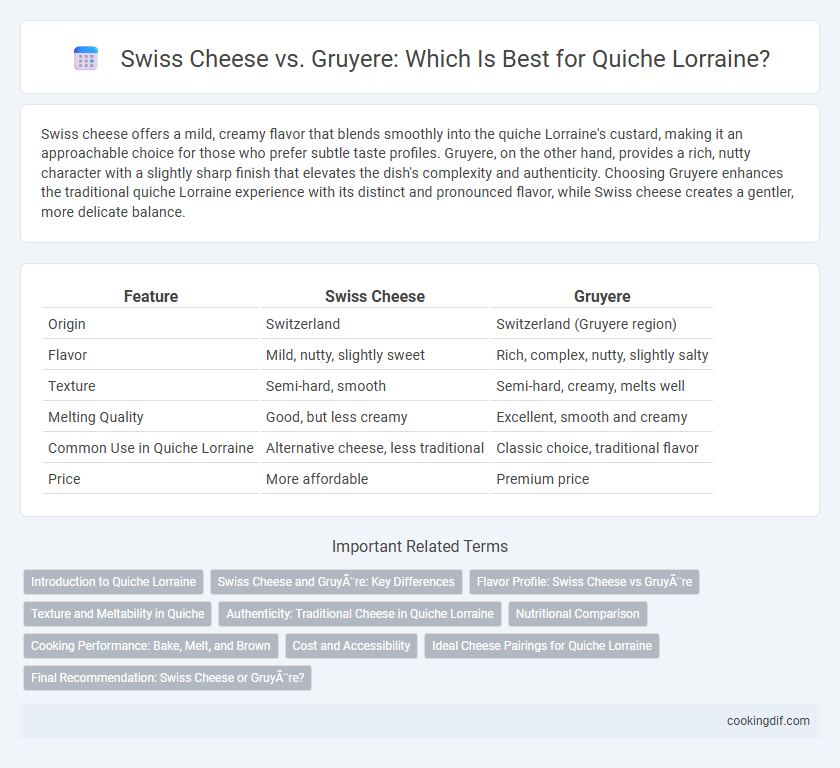Swiss cheese offers a mild, creamy flavor that blends smoothly into the quiche Lorraine's custard, making it an approachable choice for those who prefer subtle taste profiles. Gruyere, on the other hand, provides a rich, nutty character with a slightly sharp finish that elevates the dish's complexity and authenticity. Choosing Gruyere enhances the traditional quiche Lorraine experience with its distinct and pronounced flavor, while Swiss cheese creates a gentler, more delicate balance.
Table of Comparison
| Feature | Swiss Cheese | Gruyere |
|---|---|---|
| Origin | Switzerland | Switzerland (Gruyere region) |
| Flavor | Mild, nutty, slightly sweet | Rich, complex, nutty, slightly salty |
| Texture | Semi-hard, smooth | Semi-hard, creamy, melts well |
| Melting Quality | Good, but less creamy | Excellent, smooth and creamy |
| Common Use in Quiche Lorraine | Alternative cheese, less traditional | Classic choice, traditional flavor |
| Price | More affordable | Premium price |
Introduction to Quiche Lorraine
Quiche Lorraine, a classic French tart originating from the Lorraine region, traditionally features a savory custard filling with eggs, cream, and smoked bacon. Gruyere cheese, renowned for its rich, nutty flavor and excellent melting properties, is the preferred choice to complement the creamy texture of the quiche, enhancing its authentic taste. Swiss cheese, often milder and less complex, can be used as a substitute but lacks the distinctive depth that Gruyere imparts to this iconic dish.
Swiss Cheese and Gruyère: Key Differences
Swiss cheese and Gruyere differ significantly in flavor and texture, impacting the traditional taste of quiche Lorraine. Swiss cheese tends to be milder and more elastic, while Gruyere offers a nutty, rich, and slightly sweet profile with a firmer texture. Choosing Gruyere enhances the quiche with a distinctly authentic depth typical of classic Lorraine recipes, whereas Swiss cheese provides a subtler, creamier alternative.
Flavor Profile: Swiss Cheese vs Gruyère
Swiss cheese offers a mild, nutty flavor with a slightly sweet undertone, providing a subtle background taste in Quiche Lorraine. Gruyere delivers a more complex, earthy, and slightly salty profile, enhancing the quiche with rich, savory depth. Choosing Gruyere elevates the dish with its distinctive sharpness, while Swiss cheese keeps the flavor smooth and mellow.
Texture and Meltability in Quiche
Gruyere cheese offers a smooth, creamy texture and superior meltability that enhances the rich, custard base of a quiche Lorraine, providing a slightly nutty and sweet flavor profile. Swiss cheese, while also meltable, tends to have a firmer texture and a milder taste that may result in a less cohesive filling. Gruyere's ability to melt evenly without becoming greasy makes it the preferred choice for maintaining the classic silky consistency and balanced flavor in quiche Lorraine.
Authenticity: Traditional Cheese in Quiche Lorraine
Gruyere is the authentic cheese traditionally used in Quiche Lorraine, prized for its nutty and slightly sweet flavor that perfectly complements the savory custard filling. Swiss cheese, while similar, has a milder taste and less complex texture, which can diminish the classic depth of flavor associated with the original recipe. Using Gruyere preserves the traditional character and regional authenticity of Quiche Lorraine, honoring its culinary heritage.
Nutritional Comparison
Swiss cheese and Gruyere both offer rich flavors essential to quiche Lorraine, but their nutritional profiles differ slightly. Swiss cheese typically contains around 111 calories and 8 grams of protein per ounce, while Gruyere has approximately 117 calories and 8.5 grams of protein per ounce. Gruyere tends to have higher fat content and calcium levels, contributing to a creamier texture and enhanced nutritional benefits in quiche recipes.
Cooking Performance: Bake, Melt, and Brown
Gruyere cheese offers superior cooking performance in Quiche Lorraine with its smooth melt and rich browning that enhances flavor and texture. Swiss cheese tends to melt more unevenly and may produce a less creamy consistency, affecting the quiche's overall custard-like quality. For optimal bake, melt, and brown results, Gruyere remains the preferred choice due to its balanced moisture content and fine, nutty characteristics.
Cost and Accessibility
Swiss cheese offers a more affordable and widely accessible option compared to Gruyere for quiche Lorraine, making it ideal for everyday cooking. Gruyere, known for its rich, nutty flavor, typically comes at a higher price point due to its artisanal production and regional origins. Choosing Swiss cheese provides a cost-effective alternative without significantly compromising the creamy texture and meltability essential for a classic quiche.
Ideal Cheese Pairings for Quiche Lorraine
Gruyere is the traditional and ideal cheese for quiche Lorraine, offering a nutty, slightly sweet flavor that melts smoothly for a creamy texture. Swiss cheese, while similar, tends to be milder and less complex, which can result in a less rich and distinctive quiche. For authentic quiche Lorraine, selecting Gruyere enhances the balance of smoky bacon and savory custard, ensuring a classic, flavorful experience.
Final Recommendation: Swiss Cheese or Gruyère?
Gruyere cheese offers a rich, nutty flavor and excellent melting qualities that elevate the classic taste of Quiche Lorraine, making it the preferred choice for an authentic recipe. Swiss cheese, while milder and less complex, provides a creamier texture but may lack the depth of flavor that Gruyere imparts. For a traditional and flavorful Quiche Lorraine, Gruyere is the recommended cheese due to its distinctive taste and superior melting properties.
Swiss cheese vs Gruyère for quiche Lorraine Infographic

 cookingdif.com
cookingdif.com